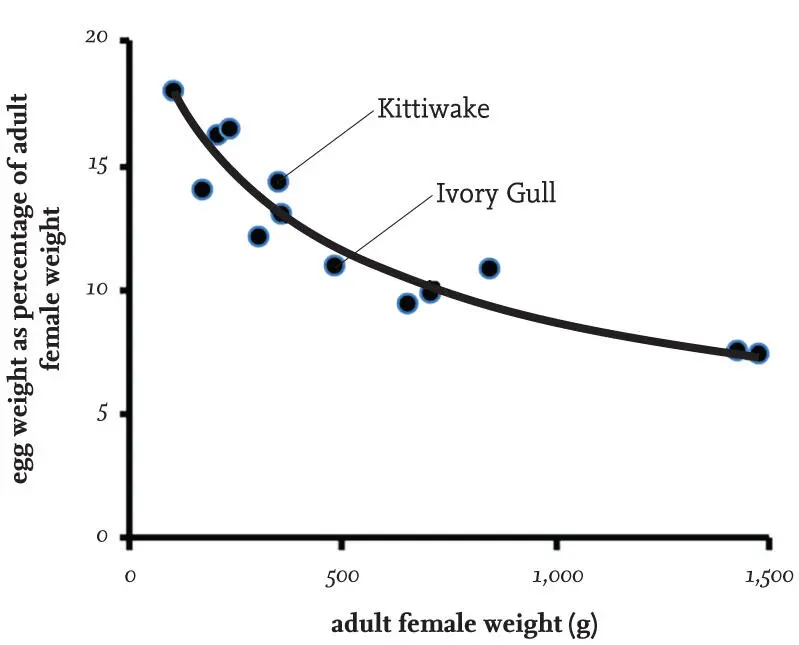Mixed colonies of Herring Gulls and Lesser Black-backed Gulls are common, but the two species show a tendency to select slightly different areas within the colony. On natural sites, they often nest side by side, but the Herring Gull more frequently nests on open ground with little or short vegetation, while the Lesser Black-backed Gull shows a partial preference for areas with taller vegetation. At urban sites, both species frequently nest side by side and there is no obvious or consistent difference in the sites they select. Great Black-backed Gulls often nest in isolation or in small numbers of pairs in colonies of Herring Gulls or Lesser Black-backed Gulls, where they frequently select sites on raised ground.
Terns often nest in association with Black-headed Gulls, with the latter arriving and laying earlier and taking the first choice of sites. However, this is not always the case – the first Black-headed Gulls to nest on Coquet Island in Northumberland did so alongside Sandwich Terns (Thalasseus sandvicensis), and only arrived after the terns had laid.
Age at first breeding and mate fidelity
Within a species, the age at first breeding is variable and can span three or more years. Smaller gulls tend to breed when they are two or three years old, while many of the large gulls do not normally start breeding until they are four or five years old. This long period of immaturity often allows individuals to visit colonies for one or more years before they breed themselves.
The claim that gulls pair for life is not justified. While the same individuals frequently re-form as a pair in successive years, ‘divorce’ often occurs, with both individuals taking new partners. Change of mate also occurs when one partner dies.
Nests
In general, gulls’ nests are often substantial structures composed of plant material collected by the adults nearby or, in some cases, picked up either from the sea surface, on the tideline or from cliff tops. Gulls that breed on marshes and ponds probably start nest-building earlier than those on drier sites, and they produce a platform above the water level on which most of the displaying and courtship takes place. In situations where the water level rises after rain, there is often an attempt by the pair of gulls to build up the height of the nest to keep the eggs dry. However, this is effective only when relatively small increases in the water level occur.
On several occasions I have seen Kittiwakes flying along the coast carrying nest material as far as 15 km from the nearest colony. This contrasts with Herring Gulls, which usually collect plant material for the nest from within their territory, although if it is not available, such as on roofs of buildings, material is collected from further away. Having collected material, adults shape a central hollow in the centre of the nest by compressing the material with their breasts. This hollow is large enough to hold the usual two or three eggs of the clutch together and prevents the eggs from rolling away by accident.
While nests of most gulls are formed by an accumulation of plant material, the exception is the Kittiwake. The adults collect marine algae and mud to form a base for the nest, and as this dries, it becomes firmly cemented to the rock surface, forming a base on which the rest of the nest is then built. The nest is completed by bringing in grass to form the top. This species is exceptional in that the adults at the nest defecate onto and over the edge of the structure, leaving obvious white streaks on both the nest and the cliff face below, and thus clearly make no effort to disguise the nest. Other gull species move away from the nest to defecate. The Kittiwake also differs from other gulls in that nest-building is often highly social, with a hundred or more individuals repeatedly flying back and forth between a particular source of mud and vegetation and the nest sites. On one occasion when in spring a local farmer spread straw and dung onto a cliff-top field, within a week the nearby Kittiwake colony was entirely draped with long strands of golden straw.
Recently fledged young and immature one- and two-year-old Kittiwakes often pick up potential nest material from the tideline and fly about with it in their beaks, but eventually drop it without taking it into a colony. I have not seen immature individuals of other gull species doing this. Non-breeding three-year-old Kittiwakes often occupy sites in a colony and bring in small quantities of nesting material very late in the breeding season, when most pairs of Kittiwakes have half- or full-grown chicks. In some cases, this forms a base for a nest in the following year. The chicks of most gulls leave the nest when a few days old, seeking cover and protection, but the Kittiwake is again exceptional in that the chicks remain on the nest until they fledge five or more weeks after hatching.
Depending on the position of the colony, some Kittiwake nests are washed off in winter storms. However, those in more sheltered positions remain over winter and until the following breeding season when they are used as the base of new nests. One nest on the Farne Islands was supported in a vertical cleft in the rock face, and as material accumulated year after year, it reached a height of more than 100 cm.
Eggs
All gull eggs have a brown or grey background with numerous spots or streaks of darker pigment, offering a degree of camouflage if they are left uncovered in the nest. The extent to which camouflage prevents or reduces predation of gull eggs has not been investigated, but it can only be one of several factors affecting successful breeding.
The size of egg laid by gulls varies with the average weight of each species, but not in a simple linear manner ( Fig. 10). At one extreme, the Little Gull lays an egg that, on average, weighs 18.6 per cent of the normal body weight of females, while the egg of the largest species, the Great Black-backed Gull, weighs only 7.3 per cent of the female’s body weight. The change in egg size as a proportion of the adult weight is a common effect in many bird groups and not just a peculiarity of gulls. Large eggs, irrespective of the species laying them, usually require a longer incubation period, although the reason for this is not immediately obvious. Presumably the body of a chick of a large gull species has more cells and requires more cell divisions before it is ready to hatch. However, that is not the only factor involved, since the eggs of birds in some other taxa, such as the Procellariiformes (petrels and shearwaters), require a much longer incubation period even when the eggs are of the same size.

FIG 10. The relationship between the average weight of adult females of 13 gull species and the average weight of the eggs they lay. The gull species that normally lay two rather than three eggs (Kittiwake, Rissa tridactyla, indicated by the lower of the two filled squares; and the Ivory Gull, Pagophila eburnea, indicated by the upper filled square) sit exactly on the curve calculated for the other species, which normally lay three-egg clutches, indicating that despite having smaller clutches they do not lay bigger eggs.

FIG 11. The relationship between the average weight of adult females of 13 gull species on the British list and the average weight of one of their eggs, expressed as a percentage of the female’s weight.
While the most frequent clutch size in gulls is three eggs, two species that occur in Britain typically lay two-egg clutches, namely the Kittiwake and Ivory Gull. This raises the question as to whether they respond by laying larger eggs. At first inspection, Kittiwake eggs look large, but this is an apparent effect of their paler background in comparison to the eggs of most other gulls (see here). Fig. 11shows the relationship between female weight and egg weight for a series of species. The relationship is curvilinear, but the Ivory Gull and Kittiwake sit almost exactly on the curve, fitting the data based on the other gull species.
Читать дальше














